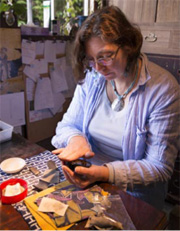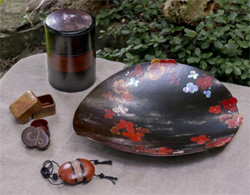Home > Highlighting JAPAN > Highlighting Japan AUGUST 2012 > A Passion for Lacquer
Highlighting JAPAN
[SERIES] MASTERS
A Passion for Lacquer
Wajima lacquerware, from the city of the same name in Ishikawa Prefecture, has a history of more than 600 years and is considered the archetypal Japanese lacquerware. The lacquerware's distinctive feature is its durability, which is produced by applying layers of urushi (the sap of the lacquer tree) mixed with jinoko (made from a kind of diatomaceous earth) onto a wooden substrate. One of the stars among Wajima lacquerware artists is Englishwoman Suzanne Ross. Masaki Yamada visited Ross at her studio in a converted barn in the Wajima mountains.

Ross at work polishing a piece of lacquerware, the last of many stages in her craft
Credit: MASATOSHI SAKAMOTO
"I just popped in to have a look. It was there that I encountered a makie (literally, sprinkled picture) inkstone box. I was smitten by the resonance of the black luster and the beautiful contrast between the background black and the design drawn in gold powder and shell. I became completely enamoured with the beauty of lacquer," Ross says.
Ross decided to study lacquer craft and, following graduation from university, she arrived in Japan.
"I had thought that lacquering was the same as painting and that if I studied for three months or so that would be enough. Was I ever mistaken! As it turns out, I ended up continuing to live in Japan and giving birth to my children here," Ross says.

From the back, clockwise, a stacking box for food, a kanshitsu (dry lacquer) dish, an MP3 player case and two trinket boxes.
Credit: MASATOSHI SAKAMOTO
Ross eventually entered the Ishikawa Prefectural Institute of Wajima Lacquer Arts to study the basic techniques. After five years of study, concentrating on makie techniques, Ross began creating independently for the first time. She then worked as a lacquer artisan for ten years, before returning to the Institute for four years to study the lacquer craft even more deeply.
Ross's dream is not just to preserve the Wajima lacquer tradition and techniques, but also to continue to develop new styles. In addition to making traditional Wajima lacquer soup bowls and other gold and silver sprinkled makie lacquerware, Ross is inventing a range of completely new Wajima lacquerware products.
"I am always looking to push the limits of the lacquer craft. For example, I have lacquered a portable music player case and made a Buddhist memorial tablet in the shape of an angel's wings. I have also used carbon fiber, which is easy to mold into any shape you want. These go beyond what has been thought of as Wajima lacquer up until now. Moreover, the division of labor has been a given in the lacquer craft but I do everything myself, from sourcing the raw materials to selling the finished product," Ross says.
Many people appreciate Ross's work and she now receives a flood of orders from all over the country.
"Whether it is music or painting, if you are truly passionate about what you do, at that instant you are in flow and completely forget yourself. Just once in my life, I'd like to create a work that makes people feel that passion and moves them into that space of forgetfulness, a place where our true humanity lies."
© 2009 Cabinet Office, Government of Japan






